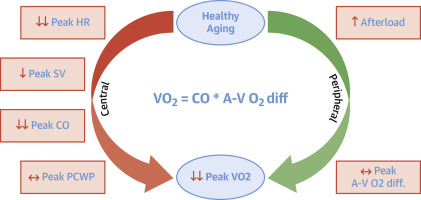当前位置:
X-MOL 学术
›
JACC Heart Fail.
›
论文详情
Our official English website, www.x-mol.net, welcomes your
feedback! (Note: you will need to create a separate account there.)
Healthy Aging and Cardiovascular Function: Invasive Hemodynamics During Rest and Exercise in 104 Healthy Volunteers.
JACC: Heart Failure ( IF 10.3 ) Pub Date : 2019-11-06 , DOI: 10.1016/j.jchf.2019.08.020 Ambarish Pandey 1 , William E Kraus 2 , Peter H Brubaker 3 , Dalane W Kitzman 4
JACC: Heart Failure ( IF 10.3 ) Pub Date : 2019-11-06 , DOI: 10.1016/j.jchf.2019.08.020 Ambarish Pandey 1 , William E Kraus 2 , Peter H Brubaker 3 , Dalane W Kitzman 4
Affiliation

|
OBJECTIVES
The aim of this study was to evaluate the association between age and invasive cardiovascular hemodynamics during upright exercise among healthy adults.
BACKGROUND
The marked age-related decline in maximal exercise oxygen uptake (peak VO2) may contribute to the high burden of heart failure among older individuals and their greater severity of exertional symptoms. However, the mechanisms underlying this decline are not well understood.
METHODS
A total of 104 healthy community-dwelling volunteers age 20 to 76 years well screened for cardiovascular disease underwent exhaustive upright exercise with brachial and pulmonary artery catheters; radionuclide ventriculography; and expired gas analysis for the measurement of peak VO2, cardiac output, left ventricular stroke volume, end-diastolic volume, end-systolic volume, ejection fraction, pulmonary capillary wedge pressure, and arteriovenous oxygen difference.
RESULTS
Over a 5.5-decade age range, there was a 40% decline in peak VO2 due primarily to reduced peak exercise cardiac output; peak arteriovenous oxygen difference was unaffected by age. The lower age-related exercise cardiac output was related to lower peak exercise heart rate and stroke volume. Aging was also associated with lower peak exercise ejection fraction, indicating reduced inotropic reserve. Peak exercise end-diastolic volume was lower with aging despite similar left ventricular filling pressure, suggesting age-related reduced diastolic compliance limiting the use of the Frank-Starling mechanism to compensate for reduced chronotropic and inotropic reserves. These age relationships were unaffected by sex.
CONCLUSIONS
The age-related decline in exercise capacity among healthy persons is due predominantly to cardiac mechanisms, including reduced chronotropic and inotropic reserve and possibly reduced Frank-Starling reserve. Peak exercise left ventricular filling pressure and arteriovenous oxygen difference are unchanged with healthy aging.
中文翻译:

健康老龄化和心血管功能:104 名健康志愿者休息和运动期间的侵入性血流动力学。
目的 本研究的目的是评估健康成年人直立运动期间年龄与侵入性心血管血流动力学之间的关联。背景与年龄相关的最大运动摄氧量(峰值摄氧量)的显着下降可能导致老年人心力衰竭的高负担及其更严重的劳力症状。然而,这种下降背后的机制尚不清楚。方法 共有 104 名年龄在 20 岁至 76 岁之间的健康社区志愿者,经过严格的心血管疾病筛查,使用肱动脉和肺动脉导管进行了力竭的直立运动;放射性核素心室造影;呼出气体分析,用于测量峰值摄氧量、心输出量、左心室每搏输出量、舒张末期容量、收缩末期容量、射血分数、肺毛细血管楔压和动静脉氧差。结果 在 5.5 岁的年龄范围内,峰值摄氧量下降了 40%,这主要是由于峰值运动心输出量降低;动静脉血氧峰值差不受年龄影响。与年龄相关的较低的运动心输出量与较低的峰值运动心率和每搏输出量有关。衰老还与峰值运动射血分数降低有关,表明正性肌力储备减少。尽管左心室充盈压相似,但随着年龄的增长,峰值运动舒张末期容积较低,这表明与年龄相关的舒张顺应性降低限制了弗兰克-斯塔林机制的使用,以补偿变时性和正性肌力储备的减少。这些年龄关系不受性别的影响。结论 健康人运动能力与年龄相关的下降主要是由于心脏机制造成的,包括变时性和正性肌力储备的减少以及可能减少的 Frank-Starling 储备。峰值运动左心室充盈压和动静脉氧差随着健康老龄化而保持不变。
更新日期:2019-11-07
中文翻译:

健康老龄化和心血管功能:104 名健康志愿者休息和运动期间的侵入性血流动力学。
目的 本研究的目的是评估健康成年人直立运动期间年龄与侵入性心血管血流动力学之间的关联。背景与年龄相关的最大运动摄氧量(峰值摄氧量)的显着下降可能导致老年人心力衰竭的高负担及其更严重的劳力症状。然而,这种下降背后的机制尚不清楚。方法 共有 104 名年龄在 20 岁至 76 岁之间的健康社区志愿者,经过严格的心血管疾病筛查,使用肱动脉和肺动脉导管进行了力竭的直立运动;放射性核素心室造影;呼出气体分析,用于测量峰值摄氧量、心输出量、左心室每搏输出量、舒张末期容量、收缩末期容量、射血分数、肺毛细血管楔压和动静脉氧差。结果 在 5.5 岁的年龄范围内,峰值摄氧量下降了 40%,这主要是由于峰值运动心输出量降低;动静脉血氧峰值差不受年龄影响。与年龄相关的较低的运动心输出量与较低的峰值运动心率和每搏输出量有关。衰老还与峰值运动射血分数降低有关,表明正性肌力储备减少。尽管左心室充盈压相似,但随着年龄的增长,峰值运动舒张末期容积较低,这表明与年龄相关的舒张顺应性降低限制了弗兰克-斯塔林机制的使用,以补偿变时性和正性肌力储备的减少。这些年龄关系不受性别的影响。结论 健康人运动能力与年龄相关的下降主要是由于心脏机制造成的,包括变时性和正性肌力储备的减少以及可能减少的 Frank-Starling 储备。峰值运动左心室充盈压和动静脉氧差随着健康老龄化而保持不变。











































 京公网安备 11010802027423号
京公网安备 11010802027423号